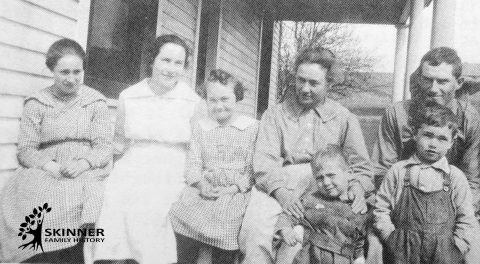The Skinner Family Nebraska
from Abernant to herman

When we researched the siblings of our great-grandfather James Skinner, we were intrigued to discover the story of his eldest brother John, who emigrated to America. ‘John Nebraska’, as we now refer to him, left his home at Abernant Farm in Monmouthshire and travelled to Nebraska, USA where he married and raised a family.
Since finding out about John we have been keen to learn as much as we can about him and his life in America. We have been helped by some excellent research conducted by the American branches of the Skinner family, particularly the work of Russell C. Lang.
John Jr. was born at Somerton Farm 8th May 1859, the son of Fife-born John and Jessie Skinner. He was named John after the Skinner’s first-born son had died at 6 days old. Shortly after he was born the family moved to the larger Abernant Farm in Kemeys Inferior, where his father had secured a tenancy.
John Jr grew up farming Abernant alongside his father and younger brother James. They achieved a great deal together and won prizes for their livestock. In 1881 aged 22, John decided to leave Wales for a new life in the USA, sailing on the SS Gloucester. With John having departed, his brother James (our great-grandfather) was left in line to succeed his father as the tenant of Abernant Farm, providing family succession could be agreed with the landowners.


John arrived in the USA and made his way to Nebraska where he settled, and in 1891 married Minnie Rose Wilson. Minnie had been born in 1870 in Blair, Nebraska, the daughter of Thomas and Mary Wilson. The family later moved to Vacoma, in northern Washington County where Minnie became a teacher at Spiker school, a small community just east of her home.
We have read that John met Minnie through her work at the school, after he was asked to safely transport Minnie to her parent’s farm on weekends. They were married 16th July 1891 and went on to have nine children. First-born was John in 1892, followed by Thomas 1894, Jim 1896, Mary 1901, Jessie 1903, Mabel 1905, Elizabeth 1908, Bob 1913, and Bill 1916. After getting married John ran a store at Vacoma, which must have been a very different life to that he had known working the fields of Abernant.
In 1894 the family moved to Spiker where they ran a store and post office, the store served the needs of families around the locality, saving trips to town with horse and buggy that usually took half a day. John would make regular trips to Herman and Blair to get merchandise for the isolated community. Travel records show that in 1896 John returned to Wales for an eight-week trip. He based himself at Penrhos Farm, the home of his sister Maggie, and caught up with family and friends. However, the main purpose of his trip was to purchase chickens and bring them back to Nebraska for breeding. You can read John’s diary from the trip here.
A batch of letters recovered by the American Skinners show that John stayed in close contact with his family throughout his time in America. Letters from his brother James, sister Margaret, niece Jessie, and nephews Wallace and Ralph, paint a vivid picture of life at home in Wales during the early part of the 20th century, and of the realities of living through WWI.


After leaving Spiker in 1900 John returned to his roots and purchased a farm on Davis creek, near Herman, population 996. Herman is a “T” shaped township in Washington County. It is bounded on its north by Burt County, on the east by the Missouri River and part way by Cuming City Township, on the south by Cuming City and Grant townships, on the west by Grant and Sheridan townships.
The Skinners successfully raised Clydesdale horses, Shorthorn cattle and Shropshire sheep, all British breeds. Tragically World War I was to have a huge impact on the family. Sons John and Thomas both volunteered for the army and travelled to Europe to fight, where Tom was killed in action in France 5th October 1918.
When the troops returned home, they brought Spanish influenza with them, exacerbating a global pandemic. John and four sons – John, Jim, Bob and Bill, all caught it during 1918. Whilst his sons recovered, John, who also suffered from asthma, succumbed to the illness, and died 18th December 1918. He is buried at Herman Cemetery. Faced with the loss of her husband, Minnie decided to continue farming with her son Jim.
In 1923 Minnie received a visit from Reg Skinner of the Welsh Skinners. Reg was the nephew of Minnie and stayed with the family for two years whilst he studied business. Reg remained close with his American cousins throughout his life. Minnie ran the farm until 1945 when she retired, Jim continued until 1950 where the census records him working 75-hour weeks on the farm. Following his retirement Bob Skinner took over the operation of the farm. Minnie died 2nd February 1953 and was buried in the Herman Cemetery.
Before his service, eldest-son John Skinner had worked for John McKay at a local feed store and after recovering from influenza he followed his father and became a farmer in Herman. He bred sheep and poultry and was a well-known member of the community. He served 28 years as a member of the Burt County Board of Supervisors and 34 years as Treasurer of the local school board. In 1914 he married Emma Hovendick and had one son, John Louis Skinner who went on to achieve notable things.


John Louis Skinner met his wife Jean in 1940, they met at the state fair where he was showing chickens. John was drafted into the U.S. Army in 1942 where he was trained as a pigeon trainer. He then served as a member of the Signal Corps before transferring to the Air Force.
After the war he went on to serve as a Professor in the Department of Poultry Science at the University of Wisconsin and was appointed the country’s first designated Poultry and Small Animal Specialist. John and wife travelled widely and in 1973 he visited Falkland in Fife and photographed his ancestors’ graves. Two fascinating interviews with John can be found online.
With the exception of Tom, the children of John and Minnie all lived long lives, marrying and raising families. With only Jim staying single, many new branches of the Skinner family were created in Nebraska and beyond. Bill Skinner was the last of John’s children to pass when he died in 2001 aged 85. Like the rest of his family, he is buried in Herman.
We came across this line from a town guide to Herman from around 1920. We thiink it nicely ends this page: “The village is surrounded by a very fertile country and its farmers are a thrifty, intelligent class of people, of many nationalities, but generally speaking, are truly thoroughgoing American citizens, who are good citizens and great home builders and appreciate the country in which they reside.”

